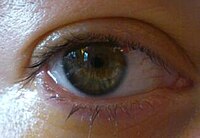
Photo from wikipedia
Objective To study the effect of treatment zone (TZ) decentration on axial length growth (ALG) in adolescents after wearing the orthokeratology lenses (OK lenses). Materials and methods This retrospective clinical… Click to show full abstract
Objective To study the effect of treatment zone (TZ) decentration on axial length growth (ALG) in adolescents after wearing the orthokeratology lenses (OK lenses). Materials and methods This retrospective clinical study selected 251 adolescents who were fitted OK lenses at the Clinical College of Ophthalmology, Tianjin Medical University (Tianjin, China) from January 2018–December 2018 and wore them continuously for >12 months. The age of the subjects was 8–15 years, spherical equivalent (SE): −1.00 to −5.00 diopter (D), and astigmatism ≤ 1.50 D. The corneal topography were recorded at baseline and 1-, 6-, and 12-month visits, and the axial length (AL) were recorded at baseline and 6-, 12-month visits. The data of the right eye were collected for statistical analysis. Results The subjects were divided into three groups according to the decentration distance of the TZ after wearing lenses for 1 month: 56 cases in the mild (<0.5 mm), 110 in the moderate (0.5–1.0 mm), and 85 in the severe decentration group (>1.0 mm). A significant difference was detected in the ALG between the three groups after wearing lenses for 6 and 12 months (F = 10.223, P < 0.001; F = 13.380, P < 0.001, respectively). Among these, the 6- and 12-month ALG of the mild decentration group was significantly higher than that of the other two groups. Multivariable linear regression analysis showed that age, baseline SE, and 1-month decentration distance associated with the 12-month ALG (P < 0.001, P < 0.001, and P = 0.001, respectively). Conclusion The decentration of the TZ of the OK lens affected the growth of the AL in adolescents, i.e., the greater the decentration, the slower the ALG.
Journal Title: Frontiers in Neuroscience
Year Published: 2022
Link to full text (if available)
Share on Social Media: Sign Up to like & get
recommendations!